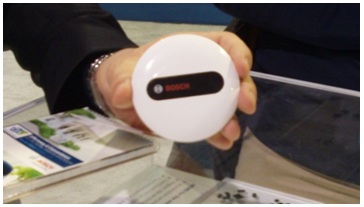You are here
CES 2014: Is the Internet of Things Connecting With You?
Every year there are a great many innovations, gizmos and gadgets at the Consumer Electronics Show in Las Vegas. There are some interesting and notable products. There were various robots that clean your home. Famibot had Ecovacs for your floor and a Winbot for your windows. There were numerous smart watches and wearables for health, fitness and medical. The activity trackers drew attention from many vendors, not only the well known Fitbit, Jawbone, Withings, Polar and Nike, but also Tractive which offers activity trackers for your pets. Even your kitty and doggie need to stay in shape not just you. The floor space for wearables appeared to be double that of last year’s CES.
One can find the usual devices at CES such as the next generation of 4K TVs including those that bend and curve. A plethora of smartphones and accessories could be seen. Are you concerned for your safety? There is the Yellow Jacket stun-gun case for the iPhone 5. There were plenty of notebook PCs and tablets on display. Many of the notebooks were the convertible 2-in-1 designs. Some have detachable keyboards so you have essentially an extra large tablet. There were more notebook models with touch screens and motion sensors so they will be able to compete with tablets. Qualcomm was showing off the next Snapdragon 805 that will ship later this year. Intel demoed tablets with the next generation Baytrail Atom CPU. These tablets are already on the market
My focus has been on the Internet of Things. There is a growing focus on this topic. The connected home was a theme for many companies. A major feature for the connected home is smart lighting. The connected smarthome also includes security, door locks, energy management, appliances and other devices and services.
Leviton, a long time player in lighting, has been involved with connectivity in the home, including security. The company has numerous products for multiple wired and wireless standards worldwide. Qualcomm had a large area for the connected smarthome where it demoed its solutions for the many technologies involved. Its Alljoyn technology is a software framework for enabling devices to connect and communicate. NXP had a huge tent devoted to the IoT. The smart lighting solution made by TCP is based on NXP’s ZigBee solution and is currently available at retailers like Home Depot. This includes a hub that plugs into Ethernet. NXP has a gateway reference design based on the ARM 9 and its ZigBee radio. The various alliances and forums involved with IoT and the connected home were well represented with several member companies showing off their current products. These included Z-Wave, ZigBee and HomeGrid.
Prior to CES, Bosch announced the formation of a new company for the Internet of Things and Services, Bosch Connected Devices and Solutions GmbH. It specializes in the development of networked sensors and actuators. At CES2014 the new CEO, Dr. Thorsten Müller, showed off a wireless sensor node module with Bluetooth. The WSN incorporates sensors from Bosch Sensortec. Bosch Connected Devices and Solutions GmbH will sell complete modules to OEMs. It will also supply any other RF that is desired.
I am selecting the Bosch WSN as my pick for CES2014. There are many products and devices performing various functions for the IoT. Bosch is providing an important enabling technology that pulls together these various devices. The WSN can be used for residential and commercial applications.
Bosch Wireless Sensor Node
The Bosch WSN includes a 9-axis IMU (accelerometer, gyro and magnetometer), microphone and light sensor. It has an ARM MCU and embeds Bosch’s sensor fusion algorithm. The sensor fusion enables context awareness. The WSN is used for cloud based security. Bosch considers its algorithm is a selling point. In addition to context awareness, it enables lower power consumption. It has a 2 year battery life with a CR123.

I spoke on a panel for the MEMS Industry Group during its session. The panel, “Wearables and MEMS Sensor Fusion”, included myself and speakers from PNI Sensors, Movea and Invensense. Context awareness is a major area of development for these companies and others involved with sensor fusion. This is moving beyond where it first emerged in smartphones. More consumer devices will be able to benefit from sensor fusion. In my presentation I noted that sensor hub controllers are being developed that are more optimized for portable applications offering more performance, lower power and lower cost. Along with falling prices for MEMS sensors, I said that in a very short time we will see wearable devices with at least 9-axis and sensor fusion on the market.
A Preview of CES 2015
As it happens, Movea and Invensense made major announcements at CES 2014. Keep in mind that my presentation was submitted to MIG before the holidays.
Invensense introduced its family of “AlwaysON” MEMS automatic activity recognition solutions for the wearable sensor market. Invensense is currently sampling ICM-20655 (world’s lowest power 6-axis motion SoC), the ICM-20955 (world’s lowest power 9-axis motion SoC) and the ICS-43430 (best in class I2S microphone). According to an Invensense spokesperson, a wearable device with Invensense 9-axis solution and embedded sensor fusion will be on the market sometime in 2014.
Movea announced a reference design for a wristband, developed with Xm-Squared, a wristband design company, and Texas Instrument’s Bluetooth Low Energy chips. The reference design is a 10-axis system using the STmicroelectronics ST32 ARM based MCU. According to Movea, products from OEMs are expected to be on the market by 2Q 2014.
Semico expects to see sensor fusion grow in the wearable devices during 2014. This will open up new uses and applications. CES 2015 holds the promise for more interesting and interactive devices connecting us more effectively to our homes and environments.

